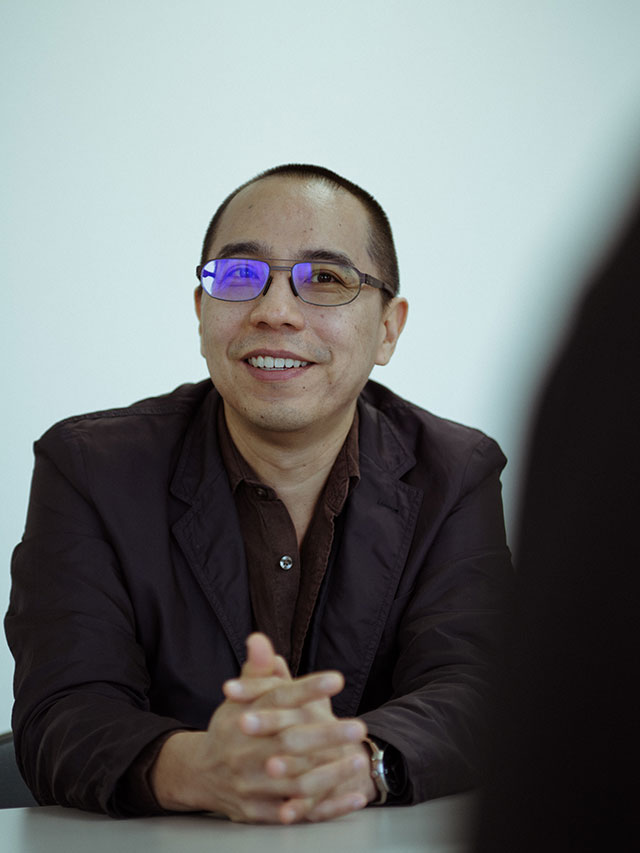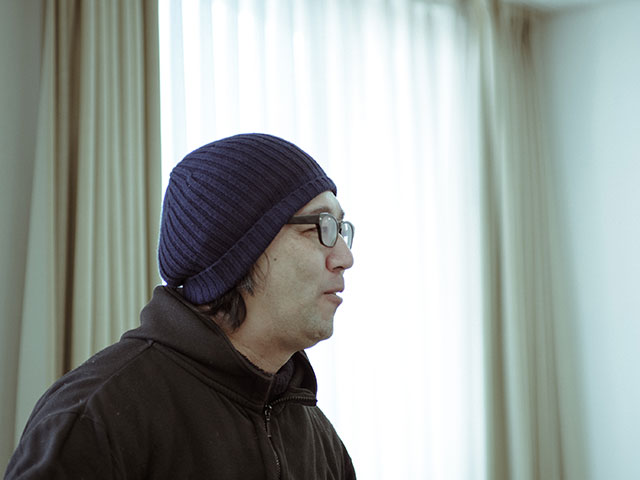
ASIA HUNDREDS is a series of interviews and conference presentations by professionals with whom the Japan Foundation Asia Center works through its many cultural projects.
By sharing the words of key figures in the arts and cultures in both English and Japanese and archiving the "present" moments of Asia, we hope to further generate cultural exchange within and among the regions.
The "shock" of Fever Room
Atsushi Sasaki (hereinafter Sasaki): I had a chance to see the first day of Fever Room (2015) yesterday, and although I had heard rumors about it, I was absolutely blown away. I am still not quite over the shock. My impression is that Fever Room contains various elements from your previous work. I would like to begin by asking you a few questions about the project. First of all, could you describe what led you to produce Fever Room?
Apichatpong Weerasethakul (hereinafter Apichatpong): When I was raising funds for my latest film, Cemetery of Splendour (2015), Kim Seong-Hee, the Artistic Director of the Asian Arts Theatre in Gwangju, South Korea, offered to provide the funding. The condition was that I produce a piece of performing arts. Since this was not a genre I felt particularly attracted to, or knew much about, my involvement in the production of Fever Room was, in a sense, accidental.
I was largely unfamiliar with theater and the onstage world, but after being introduced to a few experimental performances, I decided to take up the project and managed to experience the "onstage energy." What I mean by this is not the energy of the audience, but the energy that is present on stage. The energy of the audience is passive, while the energy on stage is in constant flux, and felt unstable to me. In any case, I regard Fever Room as a film. It does not qualify as theater in my opinion.
Sasaki: Now, you bring up a very interesting point; Cemetery of Splendour would not have materialized without Fever Room. I still believe that Fever Room could not have been produced by anybody else; it would have turned out very differently in the hands of another director. Although it may have started out conceptually as a film, as you just mentioned, I believe that audiences will experience Fever Room as something that transcends what we commonly refer to as "film," even though it may have come about as an "accident." To express this in a single project must have required extraordinary effort. What kind of ideas did you intend to bring together?
Apichatpong: The creation process was actually not that hard for me. I have my own view of the world, and rather than thinking about the feelings of the audience, I tried to become the audience and feel the images, the sound, and the light from the observer's perspective, and that was how everything came together. However, I struggled with the technical side. For that reason, I chose to work with some highly competent people in Thailand who had experience in working with video, sound, and music. Thailand has many technically skilled people among its young generation, and they eagerly welcomed my challenging and experimental approach. Throughout the course of the project, we were able to move the work forward in a very pleasant atmosphere. The young generation is free from ego and I feel incredibly fortunate that we were able to work well together. We refined the performance for each screening, and made gradual adjustments. For the screenings in Japan, as well, they helped me make refinements, resulting in incremental changes.
What was especially challenging for this project was the soundtrack. I worked with my sound designer whom I had worked with for all my projects. However, the project utilizes two spaces so, unlike before, I struggled a bit with how to screen it in a venue that was not a movie theater. But I had fun in resolving this challenge.

Stretching the Boundaries of Film―Live Cinema
Sasaki: Based on your comments, I gather that you were originally requested to create a theater production from Gwangju, and that project turned out to be Fever Room. You also mentioned that you felt the project eventually assumed the form of a film. That would seem to suggest that your conception of film significantly transcends its traditional definition. As you mentioned, I agree it is impossible to show Fever Room in an ordinary movie theater. It requires a specific environment. However, is it correct to assume that your direction in Fever Room shows that you wish to explore films in a more general sense?
Apichatpong: That is right. Fever Room qualifies as a film for me. Still, I am reluctant to put it in a narrowly defined category, and believe that is not possible to anyway. If I had to give it a label, I would call it "live cinema," or "live cinema that requires a special kind of venue." However, if you ask me why I view Fever Room as a film, I would say it is because it incorporates the entire philosophy that underpins films. For me, the philosophy of film consists of light, space and scale, and extends to film evolution and a reverence for moving images, et cetera. For instance, the scene in the cave at the beginning of the film is 2D, but once we arrive at the modern period, it becomes 4D. I define 4D as 3D with the added dimension of time. These elements are all included in the philosophy of film, in my opinion. And since they are present in Fever Room, I would position it as live cinema (if I had to label it).
Sasaki: You mentioned earlier that the project originated as an "accident," that the actual creation or thinking process behind the project was not that difficult, but that the technological aspects involved some struggles. There were at least two specific instances where we, the audience, were caught by surprise. The first was the moment when the second screen came down from above; when the second screen vertically lined up with the first one, resulting in a multi-projection. The second surprise was when the laser appeared. I assume this is part of the live cinema that you referred to just now. Is this an idea that arrived at in the thinking process after you decided to make Fever Room, or had you been eager to experiment with the idea for a while and this project seemed like an opportunity to do so. Which one was it?
Apichatpong: It was neither. Actually, I wanted to do something like this for a long time, but it was not a well-formed concept in my mind. What I mean is that I had a vague idea of what I wanted to do, but was not entirely clear about it. It was only once I started the project that I figured it out. Drawing the awareness of the audience to the screen of the movie theater has always been a component of my films. A screen is a flat object existing in a 2D world, but I feel like I managed to stretch that boundary with Fever Room; I feel I was able to go beyond conventional flat screens, and create distance and a swelling that is traditionally not visible in the space surrounding the screen. As a result, Fever Room was able to activate a space that has always been present in movie theaters, have an effect on the audience, and provide some kind of stimulus. I believe it managed to bring what was hitherto invisible to the forefront. It is a rather abstract concept to describe it, but I hope you understand what I mean.
Sasaki: I do. I strongly feel that not only in Fever Room but all your works, whether they are installations or movies being screened at movie theaters in the old-fashioned way, contain an element of "having an effect" on the audience which engages with the screen within the created space. I think this is one of the distinguishing features of your films and the cinematic worlds that you create.

Light and Materials
Apichatpong: That is right. Experimental productions involving light and other materials have always formed the heart of my productions. My works tends to span a range of fields in terms of content, reflecting personal issues, social conditions, as well as political opinions. In addition, I want to keep creating films by experimenting with the use of materials, so I am looking for such opportunities. I would like to continue experimenting.
Sasaki: Speaking about that laser part, several of my friends who saw the performance yesterday were stunned by that scene. It was an intense experience. That scene is etched in my memory, too. Does something like that require a great deal of testing or experimenting?
Apichatpong: Actually, that is not a laser.
Sasaki: Is that so?
Apichatpong: It is a video projector. We used a powerful video projector to emit that light.
Sasaki: You are saying it is a video projection?
Apichatpong: That is right. I won't have access to laser technology anyway. So I tried with a simple projector. There were few spaces in Thailand where we could thoroughly test its effects, and we ended up using a small university theater to experiment.
Sasaki: I see. You conducted simulations.
Apichatpong: Yes, we did. We also conducted simulations in Gwangju, South Korea, but most of the testing took place during actual screenings, and we also tried out new things such as overlaying graphics on top of moving images. In other words, we mostly finalized the film while testing on live audiences.
Sasaki: When the scene featuring the "laser" started in the middle part, it was so impressive that I burst into laughter. There was a part that spontaneously prompted laughter. However, one of my female friends subsequently shared her impressions on Twitter and said she felt tears welling up. I found it intriguing that one and the same scene could stir diametrically opposed emotions from the audience.
Apichatpong: I also found this an interesting phenomenon. When we learned from our staff that audience members were crying after watching Fever Room, we were all surprised. At first, we speculated the smoke used on stage may have triggered a smoke allergy, but people actually cried from emotion when watching the film. Japan is the sixth country where we are screening the project and this only happened here. We have not heard any reports of audiences crying in other countries.

The Evolution of Movies
Sasaki: Fever Room is a 90-minute long audiovisual experience that is a phenomenal work of art in my opinion. One of the major attributes of Hollywood movies is that they are increasingly moving toward the spectacular. The shift from 2D to 3D is a prime example of this. You mentioned earlier that 4D is essentially 3D with the added dimension of time. Another element that is often talked about in this respect is the mechanized seats; the IMAX theaters are also an example of this trend. The direction of making movies more spectacular to provide an experience to the audience can be frequently observed in Hollywood movies; and 3D movies are one of the drivers of this phenomenon. What you undertook with Fever Room seems to share a certain resemblance with this, but at the same time it is also distinctly different. So, turning to the topic of evolution, which you referred to earlier, Hollywood movies seem to evolve from 3D to spectacular experiences, so I wonder how you keep a distance from such movies.
Apichatpong: That is a very difficult question to answer. I was discussing this with a friend the other day and used the following analogy to explain the difference between Hollywood movies and my work: while my work can be compared to the pleasant feeling derived from sexual intimacy, I would describe Hollywood movies as pornography. It is quite a difficult concept to explain. My work is created through personal interaction. I create works that fulfill two criteria: the first is the pursuit of knowledge and intellectual reflection through personal communication with the audience; the second is the reflection of my own feelings and desires. By watching the film, it is possible to draw out a positive feeling, both emotionally and physically, which transcends one's expectations. My impression is that Hollywood movies lean more toward pornography. That is the difference.
Sasaki: I see. Even though your movies may take on the form of feature films, they are essentially very personal works of art. I feel that they are in this sense fundamentally different from, and precisely the opposite of, Hollywood movies that are produced for the mass market from the outset.
I may be digressing here, but directors such as Jean-Luc Godard and Wim Wenders have produced 3D movies, and I was wondering if you have any plans to venture into 3D?

Apichatpong: My interest is more geared toward virtual reality (VR) than 3D. However, VR technology development is still in its early stages. My hope is to be able to work on a VR project in the future. I believe film is a medium to emulate the dreams of other people, and I see VR as the indispensable next step that will allow us to express such dreams more faithfully. In particular, VR sound is technically challenging. Whether I will be able to work on something like this within my lifetime, or master the technology and shoot a film with it, I cannot answer. At the same time, the field of neuroscience is also advancing, and I believe we now live in an age where we will see new technologies emerge in quick succession. From that perspective, Fever Room is still primitive and I also feel it is not new. It is very romantic and tells a tale of light.
Sasaki: You mean to say there will be further developments as time goes by?
Apichatpong: Of course.
Expanding the Imagination
Sasaki: Allow me to ask a slightly more abstract question about your earlier comment. You mentioned that the laser was essentially a video sequence projection. In your previous work, in Phantoms of Nabua (2009) for example, an outdoor movie is projected onto a screen midway through the film. That screen catches fire and collapses in a scene that reveals a projector behind the screen projecting light in the direction of the audience. Fever Room also contains several scenes where an extremely powerful light source is moving around and brought into the audience's field of vision, and I believe this is a distinct feature of your films. Films are powered by technology and therefore constantly evolving, and we have now come to a point where even VR is becoming possible, as you mentioned. At the same time, however, your films also tend to have a more cinematic or primitive aspect. My impression is that there is not much of a distinction between the light from a projector, from the stars, or from the sun, and you handle these as essentially equivalent. Meanwhile, they incorporate both incredibly high-tech and genuinely primitive aspects. I feel these two different poles coexist in your work.
Apichatpong: That is right. I have a strong interest in fluidity. I have always believed that films derive, to a great extent, from imagination. For example, the smoke used in my movies can be regarded as genuine smoke, but the audience can also perceive it as clouds. Light can be generated from artificial lighting, but also from moonlight, so the audience can let their imagination run free.
Sasaki: In other words, you first have a concept or potential that can be expanded through imagination, and you then capture this into actual video footage.
Apichatpong: Although I do consider such an expansion through imagination, I do not like to present or dictate a direction for it. However, there is a concept that can be expanded upon, and by incorporating this in the project, the audience may assume different interpretations of what they are witnessing. This is the type of concept that I have.

- Next Page
- The Nature of Onstage Performance






